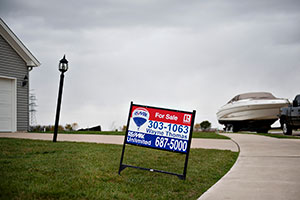Sales of Existing Homes Fell More Than Forecast in August

Sales of previously owned U.S. homes fell more than forecast in August, representing a pause in momentum this year for residential real estate.
Closings, which usually take place a month or two after a contract is signed, declined 4.8% to a 5.31 million annual rate from a revised 5.58 million pace that was the strongest since 2007, the National Association of Realtors reported Sept. 21. Prices climbed, and the number of homes on the market decreased from the same time a year ago.
Limited income growth and tougher mortgage qualifications are making it difficult for some Americans to take advantage of low interest rates and relocate after a recovery in property values. While home sales have improved this year, Federal Reserve Chair Janet Yellen said last week that the pace of improvement has been inconsistent with a firmer labor market and demographics that should provide a bigger boost.
“We’ve had very good job growth over the last couple years, and that’s typically a big driver of housing,” Scott Brown, chief economist at Raymond James Financial Inc. in St. Petersburg, Florida, said before the report. “The supply chain for housing was beaten up pretty badly, so it’s still going to take some time before that gets to be fully functional.”
The median forecast of 73 economists surveyed by Bloomberg News called for sales to ease to a 5.5 million annual rate. Estimates ranged from 5.4 million to 5.62 million after an initially reported 5.59 million pace in July.
Existing home sales, which are tallied only when purchase contracts close, account for more than 90% of the residential market.
Compared with a year earlier, purchases increased 5.4% in August before adjusting for seasonal variations.
The median price of an existing home rose 4.7% from August 2014 to $228,700. The appreciation was led by a 7.1% year-to-year advance in the West, while the South had a 6% increase.
Prices have been rising because of a lean supply of available properties. The number of previously owned homes for sale rose 1.3% in August to 2.29 million, the highest in a year. Compared with August 2014, inventory dropped 1.7%.
“We have had a tight inventory situation, and we continue to experience a tight inventory situation,” Lawrence Yun, NAR chief economist, said as the figures were released. “As consumers are hit with affordability, there’s less buying activity potentially.”
Still, home sales this year are projected to climb 7.1% to 5.29 million, Yun said.
At the current sales pace, it would take 5.2 months to sell those houses, compared with 4.9 months at the end of the prior month. Less than a five months’ supply is considered a tight market, the Realtors group has said.
Purchases decreased in three of four regions, led by a 7.8% slump in the West, the Realtors’ data show. Sales were unchanged in the Northeast.
Sales of existing single-family homes decreased 5.3% to an annual rate of 4.69 million. Purchases of multifamily properties — including condominiums and townhouses — fell 1.6% to a 620,000 pace.
Of all purchases, cash transactions accounted for about 22%, the report showed. First-time buyers accounted for 32% of all purchases in August, matching the highest share of the year, the report showed.
Still, that’s below the more normal share, which is closer to 40%, Yun said.
Distressed sales, consisting of foreclosures and short sales — in which the lender agrees to a transaction for less than the balance of the mortgage — accounted for 7% of the total, matching the lowest since October 2008.
Data last week from the Commerce Department show that builders should stay busy in the months ahead.
While residential starts declined 3% to a 1.13 million annualized rate from a 1.16 million pace the prior month that was slower than previously estimated, applications to begin work jumped. Permits for single-family home construction, the largest and most economically significant part of the market, climbed to the highest level since January 2008.
Steady job gains and historically low mortgage rates are building blocks for the housing market. At 5.1%, the U.S. jobless rate is the lowest since April 2008.
The average 30-year fixed mortgage rate was 3.91% last week, according to Freddie Mac data. That compares with the 6.06% average in the five years leading to the last recession.
Fed policymakers decided last week to keep their benchmark interest rate near zero, showing reluctance to end an era of record monetary stimulus in a time of market turmoil, rising international risks and scant inflation.
Yellen said at a news conference after the announcement that residential real estate remained “very depressed” but probably would show improvement as job and income growth improves.


